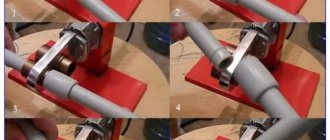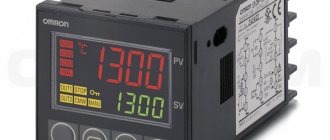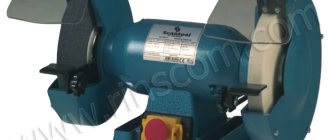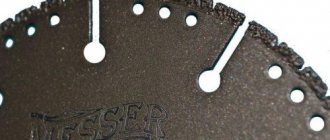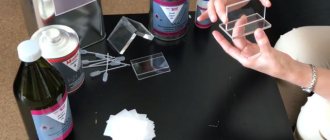| Place | Name | Characteristics in the rating |
| The best roller glass cutters |
| 1 | Matrix 87264 | The most comfortable model |
| 2 | BISON Expert 33684 | The best combination of price and quality |
| 3 | STANLEY 0-14-040 | High quality and reliability |
| 4 | STAYER 8000 M 3369 | Great option for home use |
| 5 | FIT | Inexpensive glass cutter of good quality |
| The best diamond glass cutters |
| 1 | SPARTA 872405 | The most comfortable handle |
| 2 | BISON Expert 3362 | Best tool for home use |
| 3 | Brigadier Extrema | The smoothest cut |
| 4 | COBALT 911-130 | Great resource, convenience |
| 5 | Ermak | Inexpensive option for personal use |
Glass cutters are needed not only by professional craftsmen. For owners who are used to doing everything themselves, this tool is always in a drawer with other tools that may be useful for housework. The most famous are diamond glass cutters. They appeared a long time ago and still do not lose popularity. No less common are roller models, characterized by practicality and durability. If you need to purchase this tool, but you don’t know which one to choose, check out the rating of the best glass cutters.
The best roller glass cutters
In tools of this category, special rollers made of a very durable cobalt-tungsten alloy are responsible for cutting. Their number can be different - from one to six. The tool is quite popular because of its practicality. If you have to use it infrequently, then there will be no need to purchase it again - it lasts for a very long time. More modern models include roller oil glass cutters. They work on the same principle, but are more convenient to use and smooth running due to the constant supply of a small amount of oil, which is poured into a specially designed handle.
Which glass cutter is better to buy?
One of the main criteria for choosing a glass cutter is the thickness of the glass allowed for cutting. In most cases, a model capable of working with material 5-7 millimeters thick will be sufficient.
As a rule, compact manual glass cutters are used in conditions of irregular work. In industry, special tables with guides and supports or semi-automatic machines controlled by a computer are used.
If possible, check the operation of the glass cutter before purchasing: the scratch left by it should have a minimum thickness. It is also important that the cutting element does not creak when pressed.
The most reliable and durable glass cutters are those whose heads are made of hard steel or tungsten carbide. For constant operation in conditions of high humidity, anti-corrosion treatment of the metal will also be required.
Maximum comfort when cutting glass will be ensured by the design of the handle, tapering towards the top. And it is desirable that it be covered with an anti-slip compound or have a relief.
The best diamond glass cutters
Diamond glass cutters can be called classics - they appeared on sale a very long time ago, but still do not lose their relevance due to their excellent cutting properties and long service life. Usually a stone of synthetic origin is used, but it is very durable, due to which the most even cut line is achieved, which does not require adjustment. It is somewhat more difficult for a beginner to work with a diamond glass cutter compared to roller models, but this type of tool can be called almost eternal.
Purpose of the tool
Glass is a fragile material, which makes it difficult to work with, and not everyone can do it. Moreover, if a person needs to give the product a certain shape, and not just divide it in half. To make the cutting process easier, many manufacturers offer the use of special tools. After all, thanks to them, the process improves, and a person does not have to spend a lot of time on it. In addition, beginners can use a glass cutter; there is nothing complicated about this device.
During work, you only need to mark certain areas and, with a little effort, break off the unnecessary part. In theory, everything is easy, but in practice, a person is faced with the fact that part of the glass may remain or the material may crack altogether. To prevent this from happening, it is important to use high-quality models.
Types of glass cutters and their prices
Glass cutters, based on design features, are divided into the following types:
Diamond
As mentioned earlier, the working element is a solid diamond crystal, which, like any other cutter, can wear out over time.
There are two types of cutters in shape: with a curved cutting edge - mounted on the same axis with the tool, and with a tetrahedral edge in the shape of a pyramid - mounted relative to the axis of the tool at an angle of approximately 20 degrees.
The first option is more suitable for beginner carvers, while the second can only be handled by professionals with extensive experience.
When the cutter wears out, it is allowed to sharpen it on a block or cast iron disk using mastic based on diamond dust.
Both natural and artificial (synthetic) diamonds are used in the production of tools.
The second, naturally, is much cheaper (from 500 rubles for a relatively high-quality option), however, the first provides cutting of thicker glass.
The cutting element itself is capable of withstanding cutting about 10 thousand linear meters of material.
The average price for a tool with natural stone is 1,500 rubles.
Pobeditovy
With roller cutter made from pobedit.
Structurally, it is similar to the previous option, however, it has a significantly lower cost and is also of little use for glass work.
During the cutting process, a carbide cutter quickly becomes dull and leaves a poor-quality groove, which is why it is extremely rare even among home craftsmen.
Roller
Perhaps the most common option.
The cutting is performed with a carbide rotating roller.
There are mainly models with 1, 3 and 6 rollers on the market.
In the first case, the element is fixed in a fork-shaped holder, like a bicycle wheel, and is capable of cutting about 350 linear meters of material, after which it becomes dull and requires regrinding, on both sides.
Three-roller models, as well as those with a large number of rollers, use a revolving-type holder.
In other words, if one element fails, it is enough to unscrew the fastening screw and rotate the holder, placing the next roller in the working position.
There are also two-roller models, the body of which, as is typical for a cheap tool, is made of plastic.
Glass cutters with six blades and a rotating head are more durable, as they allow you to work with large volumes of material precisely due to the number of rollers.
A good glass cutter with a steel cutting wheel will cost about 700 rubles, and the minimum price for the roller version is 90 rubles.
Oil
It is a modified previous version.
Its feature is the presence of a small reservoir into which oil is poured, which is supplied during operation directly to the cutting element continuously and automatically.
The reservoir is often a hollow cylindrical or rectangular (with rounded edges) handle, which has protrusions for the fingers for easy holding.
This solution made it possible to reduce roller friction, thereby increasing the service life of the tool.
Also, smooth movement affects the quality of the cut for the better.
This glass cutter can handle 5,000 linear meters of glass, the maximum thickness of which is 20 mm.
The minimum cost is 160 rubles.
Compass glass cutter
Designed for cutting regular circles.
Its design, as the name suggests, is based on a circular mechanism.
The reference point in this case is a suction cup, which fixes the entire structure on the glass plane.
A scale and a cutting element are attached to the suction cup, capable of moving along the latter to adjust the radius.
This version of the tool is also called a radius tool, since the distance between the fulcrum and the cutter is fixed while working.
Circular glass cutter
A more complex subtype is a circular glass cutter for cutting out ovals.
It already has two centers, and the cutter moves during operation along a complex trajectory, ultimately forming a closed ellipse.
The trajectory itself, in fact, consists of sections of circles having different diameters.
Price – about 1 thousand rubles.
The last type of glass cutter in most cases is a symbiosis of an oil tool and a compass mechanism.
Special glass cutter
The tool is designed for serial cutting of glass in circles of small diameter.
It has an original design in the form of a flat circle on which a rod is mounted with a cutter that moves along it to select the desired diameter.
The rod and cutter have locking elements to prevent them from shifting.
For ease of operation and movement of the glass cutter, a handle in the shape of the letter “L” is attached to the main structure.
Features of glass cutting technology
Before cutting glass, it is necessary to properly prepare the material. The glass should be washed from dust and thoroughly wiped with a dry cloth. If there is debris in the path of the cutting tool, the cutting angle may change, which will not only lead to defects, but may also damage the tool. The debris can be completely unnoticeable particles of glass chips or fragments. Even ordinary dust can significantly affect the quality of the cut.
The flat surface to be processed should be level and without slopes. In addition to the glass cutter, you need to prepare a marker and a thick ruler to mark the cutting line.
When using a diamond glass cutter, no special effort is required. The tool must be pressed with approximately the same force as a pencil. It can be difficult for beginners to set the correct direction to the cutting element and select the appropriate angle of inclination. To understand the principle of operation, you can practice first on a sheet of rough material. After making a thin linear cut, you need to remember what position the glass cutter was in, and use the same principle to do it on a normal sheet. To make the cut easier, you need to move the tool evenly along the length of the ruler without changing the pressure on the tool or the angle of inclination.
Roller glass cutters must be held perpendicular to the plane of the material. Along the edges of the sheet, small linear markings are made with a glass cutter, thanks to which the pressure on these fragile parts can be eased. Otherwise it will lead to chipping. After this, you need to step back with a ruler from the markings to the width of the cutting element and make the cut. The work must be done from the far edges; the glass cutter should be brought towards you, pressing its side tightly against the ruler.
The cut must be done quickly. Thus, it takes about 2 seconds to travel 1 m. When working with a roller glass cutter, it is necessary to apply more force than when working with diamond tools, and the pressure should not be changed along the entire length, except for the edges.
How correctly the instrument is used can be determined by hearing. If there is a steady hissing or crackling sound, we can say that the work is being done correctly, but if squeaks or squeaks occur, this indicates that something is being done incorrectly. This indicates that the tool is dull or the pressure is too weak. The presence of small white fragments on the line may indicate overdoing the pressure, so it should be slightly loosened.
A high-quality cut will make it possible to easily break the glass and obtain smooth edges.
Defective lines or glass that is too thick will need to be tapped on the other side of the sheet. To do this, you need to move the glass to the edge of the working surface so that the linear cut is 5 mm from its edge. Then, using the head of the tool, you need to tap along a line from the top edge of the sheet to the bottom. Due to this, microcracks are formed, which make it easy to break off the material being cut. You can use the side of a glass cutter or pliers to break off small strips of glass.
How can you make a glass circle?
How to cut correctly with a glass cutter if such a workpiece is required? There are several ways to achieve your goal. However, the choice depends on several factors - the diameter of the product, the thickness of the glass.
The most logical option is to use a circular glass cutter. But such a tool is very rarely found on the farm. Therefore, you often have to look for a replacement device. An alternative exists: this is a compass tool made from a regular glass cutter. The work consists of several stages.
- First, mark the center of the future figure on the glass. A suction cup is attached to it.
- A strong thread (fishing line) is tied to it, and a glass cutter is tied to its other end, but so that the length of the rope is equal to the radius of the future circle.
The thread is pulled, then a line is drawn with the tool. Additionally, perpendicular cuts are made on four sides of the glass; they will allow you to “extract” a circle from the material without any problems. If the leaf is large, then many rays are drawn. Take the glass in your hands and gently press on its edges from all sides. After this, the “extra” elements are quite easily broken off from the circle.
Subtleties when carrying out work
- The diamond glass cutter is operated without pressure along the entire line. When using a roller glass cutter, apply light pressure.
- Pressure should be measured, as too much pressure may create excessively deep grooves, the edges of which will crumble and chip.
- At least 5 mm from the edge of the sheet, the pressure should be reduced. This will eliminate defects and prevent damage to the instrument.
- It is forbidden to cut the same line twice with a glass cutter.
- Before starting work, the surface of the glass roller is lubricated with a pre-soaked sponge. Diesel fuel, oil or paraffin can be used as impregnation.
- It is necessary to break the glass immediately after the material has been cut.
- The size of the cut plane should not be less than the thickness of the sheet itself. For example, if the thickness of a glass sheet is 6 mm, and it is necessary to cut 5 mm from the edges, then this will be quite difficult to do.
- When working with ordinary glass smaller than 5 mm, tapping is not required.
- Tapping can be replaced by heating the cut line with a blowtorch.
- You should break a sheet of glass correctly; to do this, you need to place a ruler under the glass, the thickness of which is 5 millimeters or more.
Rating of popular roller models
STANLEY 0-14-040
The device is suitable for both industrial and domestic use. Equipped with 6 rollers, which are tightly fixed with a screw. The handle is made of wood, varnished. There are also grooves that make it easier to grip the glass. Glass is cut quickly and efficiently, with no effort required. The operating life of the tool is over 5000 meters, which is a positive result.
The average cost is 690 rubles.
glass cutter STANLEY 0-14-040
Advantages:
- Accurate cut;
- Easy to use;
- Efficiency;
- Strength characteristics;
- Durability;
- Comfortable handle.
Flaws:
- Not found.
Glass cutter STAYER series “STANDARD”
A cheap device that has only 3 rollers, but the quality of the cut remains at the highest level. Instead of wood, the case is made of high-quality plastic, which does not slip in the hand and does not deteriorate over time. This solution allows you to increase the service life of the glass cutter, as well as improve the strength characteristics.
Rollers made of metal alloy provide fast and easy cutting. The user does not need to make any effort. In addition, the tool has a special coating that allows it to be used in all weather conditions and also simplifies storage. The depth of the cut is 5 mm.
Sold at a price: from 120 rubles.
glass cutter Glass cutter STAYER series “STANDARD”
Advantages:
- High-quality assembly;
- Reliability;
- Durability;
- Convenience;
- Quick cut
Flaws:
- Not found.
Hardax 46-3-000
A reliable model, the cutting part of which is made of VKZ brand hard alloy. This solution significantly increases the performance characteristics and allows cutting material with a thickness of no more than 4 mm.
There are 2 rollers, which ensure comfortable use and accurate cutting, even after a dozen processed products. The handle is made of durable plastic, which has a convenient shape, which allows you to work with maximum comfort.
The average price is 128 rubles.
glass cutter Hardax 46-3-000
Advantages:
- Low cost;
- Good quality;
- Suitable for home use;
- Reliability.
Flaws:
- Not detected.
SIBRTECH glass cutter 3 rollers
A good model that will help cut 3-4 mm glass without much effort. There is a convenient holder that can quickly break off an unnecessary part. The handle is made of high-quality wood and coated with a protective layer, which improves performance.
The average cost is 160 rubles.
glass cutter SIBRTECH glass cutter 3 rollers
Advantages:
- Efficiency;
- Strength;
- Price;
- Convenience.
Flaws:
- Not detected.
KRAFTOOL roller glass cutter 33675
A professional tool that has a service life of 10,000 meters and is able to cope with glass no more than 10 mm thick. The cutting part is made of high-quality and wear-resistant steel. The handle is made of plastic, but it is made in a comfortable shape, which provides good ergonomics during operation.
Sold at a price: from 535 rubles.
glass cutter KRAFTOOL roller glass cutter 33675
Advantages:
- Smooth and neat cut;
- Optimal price;
- Capable of cutting material up to 10 mm;
- High work resource;
- Strength.
Flaws:
- Not found.
How to cut with a glass cutter?
Using a glass cutter effectively, while avoiding a large amount of waste, is not so difficult if you follow the given sequence of actions:
- The glass is cleaned of any contaminants and dried. Next, the sheet is laid on a flat and soft surface, for example thick fabric or felt.
- Before you start working directly with a glass cutter, you should prepare a paper plan for cutting glass.
- The cutting process is as follows: for ease of work, take a template or ruler, which must fit tightly to the sheet, and in addition, does not slip on the glass surface. The glass cutter is held at the base of the handle. A line is drawn, starting from the far edge, without pressure, and the characteristic cracking of the glass is heard. The result will be an almost invisible scratch, if we talk about a diamond tool.
The roller version requires stronger pressure, and the result will be a deep white line. This work is always done at one time, and in case of any error, the sheet is turned over and a new line is drawn on the reverse surface. - The last stage is glass breaking. To do this, wear protective gloves on your hands. On the back side of the glass, light tapping is performed with a mandrel, which will simplify the process. Next, the sheet is placed on the edge of the table along the cutting line, after which it is broken off with a sharp downward movement. If, as a result, the presence of narrow strips is observed, they are broken off by grooves lined with paper or rubber.
To make the edge of the glass smooth, wear safety glasses and use a drill with a sharpening attachment clamped in the chuck.
Selection factors
You should select a glass cutter depending on the following circumstances:
- For what purposes will the tool be used? It is clear that, for example, a professional glass cutter must be able to cut glass of any thickness, be able to make shaped cuts, etc. The requirements for household glass cutters are simpler.
- From the thickness of the material.
- From the shape of the cutting head.
- From the hardness and texture of glass.
- From the working conditions of the master. For example, when using a glass cutter in a laboratory environment, there should be no oil in the cutting area.
- From accessories. When using a tool for making curved cuts (for example, for stained glass), you also need to think about the template.
Glass cutters are distinguished by the material of the working tool. The most expensive ones are diamond ones, but quite decent competition comes from quick cutters for glass, the working rollers of which are made of alloyed tool steels such as R12F4K5, R6M5K5, etc., with an edge hardness of at least 62...64 HRC. Glass cutters with rollers made of hard alloys of the VK3 type are also common.
Finally, an important role in choosing a glass cutter is played by its ergonomics, in particular the shape and location of the handle. It is useful to stock up on a stand on which to store the instrument. The best stands are those that include a container for oil. While in an oil bath, steel working rollers are cleared of oil, are less susceptible to corrosion, and maintain their sharpening angle longer.
How to choose the standard size of a glass cutter? Let's look at the most common options.



